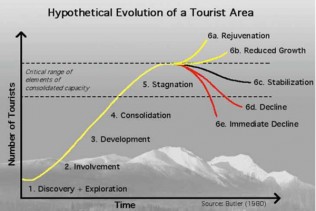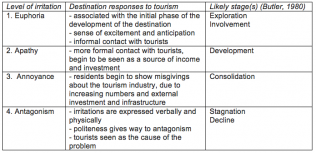In any tourism destination, the local population must possess the capacity to maximize the benefits of increased visitation. Investments in sustainable development must be accompanied by investments in local education, especially in nations where funding for education is limited. Without such investments, it will remain difficult achieve positive and sustainable, regional economic development, as well as improve quality of life for locals.
In many cases, a significant percentage of the direct profits from increased tourism visitation escape the local economy. Often, this means that local benefits only extend so far. When locals begin to realize the extent of their “glass ceiling,” many begin to regret their willingness to open their doors so eagerly. In this case, a dangerous rift may form between visitors and the host population.
Butler’s “Tourism Life Cycle”
In 1980, Professor Richard Butler outlined six stages in the tourism life cycle. Butler suggested that every tourism destination exhibits an identifiable evolution process. In cases where tourism is overly relied upon as a primary economic driver, local economies become devastated when the destination rapidly declines, both in terms of offerings and popularity.

Butler explains his model well:
“Visitors will come to an area in small numbers initially, restricted by lack of access, facilities, and local knowledge. As facilities are provided and awareness grows, visitor numbers will increase. With marketing, information dissemination, and further facility provision, the area’s popularity will grow rapidly. Eventually, however, the rate of increase in visitor numbers will decline as levels of carrying capacity are reached. These may be identified in terms of environmental factors (e.g. land scarcity, water quality, air quality), of physical plant (e.g. transportation, accommodation, other services), or of social factors (e.g. crowding, resentment by the local population). As the attractiveness of the area declines relative to other areas, because of overuse and the impacts of visitors, the actual number of visitors may also eventually decline.”
Doxey’s Irridex
Five years before Butler proposed his model, George Doxey examined the evolution of host-visitor interactions. His findings helped him develop what is now known as Doxey’s Irritation Index, or “Irridex,” for short. Doxey’s model suggests that attitudes amongst the host population in a given destination are likely to progress through four distinct “levels of irritation.”

Most host populations begin with excitement and anticipation. Tourism planners and developers promise substantial economic gains. The idea of improving the local economy and bolstering regional quality of life while welcoming guests from around the world and sharing a slice of local culture appears to be a win-win. In the initial stage of “euphoria,” visitors are welcomed with open arms. Unfortunately, planning to sustainably meet the inevitably variable demands of visitors is often minimal.
Slowly in some cases, and more quickly in others, the host population will begin to take visitors for granted. Interactions between hosts and visitors become more formal and a destination’s reputation for boasting a warm and welcoming local population starts to become compromised. This is known as the stage of “apathy.”
When any given destination reaches the saturation point, host attitudes quickly turn negative. This level of irritation is characterized by ‘annoyance’. Some locals may begin to express concerns and misgivings about inadequacies in their slice of the “tourism pie.” In response, many planners mistakenly attempt to keep a destination viable by increasing infrastructure, rather than limiting growth.
In the fourth and final level of irritation, categorized as “antagonism,” members of the host populations reach their breaking point. In the worst cases, this results in direct host-visitor conflicts, as more hosts start to openly show their frustration. Despite growing tension, planners often increase destination-marketing efforts in an attempt to shore up the destination’s deteriorating reputation, although it may be wiser to limit growth and seek a healthy means of alleviating conflict, such as dispersing benefits more equally.
The Need for a More Holistic, People-First Approach
Tourism, while touted as an economic savior for many developing nations, can have devastating effects on destinations that are ill prepared to truly benefit from a boom in year-round visitation. Pollution, widening income gaps, and tense interactions between hosts and visitors are just a few examples of the negative effects of hasty tourism development.
When pursued in an ethically responsible manner, however, opening new destinations to tourism visitation has the potential to break down cultural and ethnic divides, smash class barriers, and improve global quality of life. While many destinations appear prosperous from the friendly grounds of the resort, locals living just miles down the road still face with major challenges, including, but not limited to, lack of access to clean water, healthcare, and education, as well as high rates of infant mortality and below average life expectancy.
As a rapidly expanding global industry, tourism development should be pursued as a tool for improving quality of life around the globe. A continued adherence to development initiatives that serve corporate interests over the needs of the world’s impoverished and disenfranchised populations will continue to stymie the industry’s ability to reach its full potential.
Changing Gears
Shifting the purpose of tourism’s current “development mission” is no small task, but the corporations driving global tourism development must be held accountable to the pursuit of an ethically-sound vision. We can start by increasing awareness of the all-too-often unequal distribution of tourism “benefits,” as well as investigating how the industry can contribute more positively on an international scale.
Fortunately, there are already many organizations committed to these purposes. If momentum is to continue in a positive direction, however, the individuals that work in, and rely on, the tourism industry for their livelihood must have an equal seat at the table. Please visit the United Nations Foundation’s site to read more about efforts to promote sustainable tourism development worldwide!
Read Ethical Traveler's Reprint Policy.
